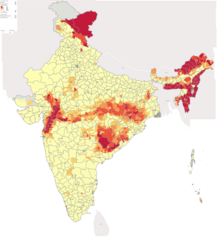阿迪瓦西
Adivasi指的是印度东部、中部、西部和南部的异质群体。[1][2][3][4] 该词是 1930 年代由政治活动家创造的梵语词,旨在通过声称原住民血统来赋予部落人民原住民身份。[5] 该词也用于少数民族,例如孟加拉国的 Chakmas、尼泊尔的 Adivasi Janjati 和斯里兰卡的 Vedda。 印度宪法没有使用 Adivasi 这个词,而是指在册部落和 Janjati。[6] 印度政府并未正式承认部落为原住民。 该国批准了国际劳工组织 (ILO) 关于联合国原住民和部落人民的第 107 号公约 (1957),并拒绝签署国际劳工组织第 169 号公约。[4] 根据印度宪法规定,这些群体中的大多数都包含在在册部落类别中。[7]

他们是印度和孟加拉国的少数民族人口,占印度人口的 8.6% 和孟加拉国人口的 1.1%[8],根据 2011 年人口普查,印度有 1.042 亿人,根据 2010 年人口普查估计,孟加拉国有 200 万人。[9][10][11][12] Adivasi社会在以下地区特别显著:特伦甘纳邦、安得拉邦、恰蒂斯加尔邦、古吉拉特邦、贾坎德邦、中央邦、马哈拉施特拉邦、奥里萨邦、拉贾斯坦邦、西孟加拉邦和印度东北部,以及安达曼-尼科巴群岛,以及费尼县、科格拉焦里县、班达尔班、兰加马蒂,还有科克斯巴扎尔。
尽管自称是印度的原始居民之一,但许多现代原住民社区是在印度河谷文明衰落之后形成的,拥有来自古代狩猎采集者、印度河谷文明、印度雅利安人、南亚语系使用者和藏缅语族使用者。[13][14][15] 蒙达语族使用者的祖先大约在 4000至3500 年前自东南亚移民而来。[16]
部落语言可分为七个语言分组,即安达曼语系、南亚语系、达罗毗荼语系、印度-雅利安语支、尼哈利语、汉藏语系、壮侗语系。[17]
印度东部、中部、西部和南部的部落使用政治上断言之措辞 Adivasi,而印度东北部的部落使用“部落”或“在册部落”,且不使用“Adivasi”。[2] Adivasi 研究是一个新的学术领域,借鉴了考古学、人类学、农业史、环境史、属下研究、原住民研究和发展经济学。 它增加了针对印度相关脉络的辩论。[18]
参考资料[编辑]
- ^ Engin F Isin. Citizenship After Orientalism: An Unfinished Project. Taylor & Francis. 2015: 213 [2023-04-02]. ISBN 978-1-317-68137-3. (原始内容存档于2023-03-23).
Widely addressed as tribals, Adivasis are heterogeneous groups spread all over the nation having different languages and group identities.
- ^ 2.0 2.1 Sangeeta Dasgupta. Adivasi studies: From a historian's perspective. September 2018 [29 September 2022].
- ^ Adivasi | people | Britannica. www.britannica.com. [2023-04-02]. (原始内容存档于2021-03-01) (英语).
- ^ 4.0 4.1 Rousseleau, Raphael. Claiming Indigenousness in India. Books & Ideas. 7 February 2013 [2023-04-02]. (原始内容存档于2021-01-21).
- ^ Robert Harrison Barnes; Andrew Gray; Benedict Kingsbury, Indigenous peoples of Asia, Association for Asian Studies, 1995 [2008-11-25], ISBN 978-0-924304-14-9,
The Concept of the Adivāsi: According to the political activists who coined the word in the 1930s, the 'adivāsis' are the original inhabitants of the Indian subcontinent ...
- ^ We are 'Scheduled Tribes', not 'Adivasis'. Forwardpress. 26 October 2018 [28 September 2022]. (原始内容存档于2022-09-28).
- ^ We are 'Scheduled Tribes', not 'Adivasis'. Forwardpress. 26 October 2018 [28 September 2022]. (原始内容存档于2022-09-28).
- ^ Bangladesh - The World Factbook. Cia.gov. [2021-07-10]. (原始内容存档于2021-02-13).
- ^ 2011 Census Primary Census Abstract (PDF). Censusindia.gov.in. [2023-04-02]. (原始内容存档 (PDF)于2020-08-05).
- ^ SCs, STs form 25% of population, says Census 2011 data – Indian Express. archive.indianexpress.com. [2023-04-02]. (原始内容存档于2017-07-16).
- ^ CPI(M) demands reservation for SCs, STs in private sector. DNA India. 16 April 2015 [2023-04-02]. (原始内容存档于2019-07-14).
- ^ Bangladesh | World Directory of Minorities & Indigenous Peoples. Minority Rights Group. 19 June 2015 [2021-07-10]. (原始内容存档于2021-07-10) (英国英语).
- ^ Reich, David; Thangaraj, Kumarasamy; Patterson, Nick; Price, Alkes L.; Singh, Lalji (2009), "Reconstructing Indian population history", Nature, 461(7263): 489–494, Bibcode:2009Natur.461..489R, doi:10.1038/nature08365, ISSN 0028-0836, PMC 2842210, PMID 19779445
- ^ Basu, Analabha; Sarkar-Roya, Neeta; Majumder, Partha P. (9 February 2016), "Genomic reconstruction of the history of extant populations of India reveals five distinct ancestral components and a complex structure", Proceedings of the National Academy of Sciences of the United States of America, 113 (6): 1594–1599, Bibcode:2016PNAS..113.1594B, doi:10.1073/pnas.1513197113, PMC 4760789, PMID 26811443
- ^ Narasimhan, Vagheesh M.; Patterson, N.J.; et al. (2019), "The Formation of Human Populations in South and Central Asia", Science, 365 (6457): eaat7487, doi:10.1126/science.aat7487, PMC 6822619, PMID 31488661
- ^ Scientists solve genetic puzzle surrounding Mundas. down-to-earth.org. 12 March 2019 [17 November 2022]. (原始内容存档于2022-09-25).
- ^ TRIBAL LANGUAGES IN INDIA – INTRODUCTION (1/4). Wordsinthebucket.com. 7 April 2015 [24 September 2019]. (原始内容存档于24 September 2019).
- ^ Sangeeta Dasgupta, "Adivasi studies: From a historian's perspective." History Compass 16.10 (2018): e12486 https://doi.org/10.1111/hic3.12486
